Arrived 09/19/20 at 2:30pm and left at 4:45 pm.
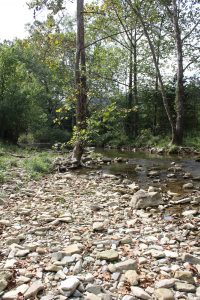
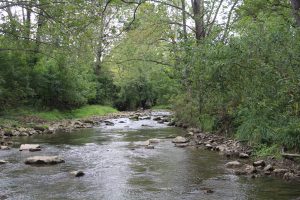
My sit spot is at Tinker Mountain on its hiking trails. I understand that people are and can be involved but this is a less traveled area. My tinker trail is a part of the 5 hour, 15+ mile hike that takes you completely up the mountain to the peak cliffs at the top of the mountain. This means that this trail is more difficult and does not hold a larger crowds because more experience is needed for it (in my opinion-I am from flat land Maryland so I don’t know how Virginia people role). The trail you must go down in order to get to the creek is the Andy Layne Trail. From there it is a straight shot upward and downward over rocks and an overgrown path that will eventually lead you to a big crossing bridge. There’s a place to leave for the creek immediately at the beginning or end of the bridge that leads immediately to the rock beaches on both sides of the creek. Once you’re on the beach, my spot is a way down until you hit the first bend-probably 50 feet off the path. It’s a grass spot between two down trees, with tall flowers and vine-y bushes surrounding the trees. In order for me to get to the water, I go down a small embankment and into the water. The part of the creek that I am near has more intense riffles directly in the middle and larger rocks, but the sides going out about five feet towards the middle are eddies.
After the previous rain shower we just had, the water and action throughout my area changed a lot. During my 15 minutes I saw only movement from the creek; going from the water movement to occasional fish heads popping out. There were occasional dragon flies and a few bees over the some of the flowers, but the bug population was completely gone. This was the same about the birds. I only heard a few but it was a lot quieter. The water was the loudest thing around me. It also smelt muddier because of the rain and the ground was squishy and soft, I left a lot of imprints walking through the grass and harder, set land then I had the last time I was there. Also, my sitting spot was a lot grassier than how it had been and was more comfortable to sit in. It was a lot cloudier and cooler than my last visit. I think this is why there was a lot change. The sun didn’t come out and there was a slight breeze and smelt like rain. I did not see my Georgia Robber Fly! I don’t know where they went. I believe it might have the temperature and weather that caused them, like a lot of the other bugs, to stay less active. The vegetation changed a lot. Many of the flowers had wilted or were almost done with losing their full pedals. There were only a few lance-leaf coreopsis and daisies left along the edge of the rock beaches. It was mainly just green everywhere-there were only a few trees that were slowly turning yellow for fall but that was it. The dens I wanted to keep watching were still the same and one looked like something had or is still creating a covering for one of the openings! This the den that is in one of the fallen trees that looked like it could still be used and had activity in it previously. The other den, which is on the other side of the creek, did not looked used yet but that could change once it starts getting cooler out.
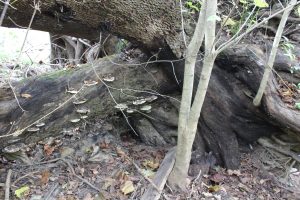
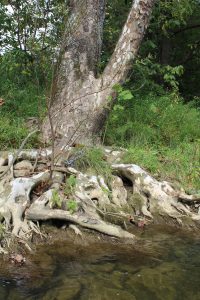 The two dens I am watching, the one on the left is the more active one and the right one could have possible activity!
The two dens I am watching, the one on the left is the more active one and the right one could have possible activity!
I paid attention more to the water patterns and organisms, and the other side where the vegetation was thicker. I chose to examine the water patterns because of how fast they changed through the course of just walking from one side to the other. There were shallow and deep, fast riffles but then a few feet ahead of those it would be an eddy that went from a few inches deep to past my knee. The water pressure of the movement throughout the stream was strong but would just cut off and I couldn’t feel it then I’d take another step and it would be back. I enjoyed watching how the organisms, such as the little minnows, bigger fish, frogs and bugs on the water surface, reacted to these changes in water patterns. I followed the minnows and watched how they used the riffles in order to get into an eddy. I also payed attention to the large fish that stayed within the deeper eddies and picked through the plant and tree roots that contained food for it. They would shake their bodies with in the roots and whatever came off, they swam around quickly and ate it and would speed off to another spot. These fish also breached the most to get bugs on the surface. Lastly for the creek, I watched the insects, which were just the small, spider like, water bugs that skimmed across the water top and the small black water beetles that swam mainly under water. I watched and realized the beetles went in between the riffles and eddies where the other bugs stayed in the eddies and away from the fast moving water because they couldn’t stay afloat. I thought it was interesting seeing how both types of bugs used their type of water choice and how they moved within them. I saw a frog basking on a large rock but quickly lost it as it launched itself into the bushes-it was a large, brown and green studded bull frog. Then I moved on to the other side where the vegetation was more thick because I wanted to see if there was a difference in mammal activity then what I had viewed on my side from my first visit. There were a lot of spots that looked like they would make stable dens or coverage but did not look they had any or a lot of activity. It was tighter to move through only because the underbrush was in the way more and the trees were closer together. During this exploration I did use my sight mainly, but I changed my focus on certain spots using my sense of smell, sound, and touch. When I went for my walk around, I took my shoes off to walk through the creek and on the other side. The rocks were VERY hard to travel over and with the additional push of the water movement going against or with me, it was hard to keep balance. The rocks weren’t sharp, but they went from being 2 inches to over 2 feet in size. The water was very cold but smelt fresh and smelt like wet leaves or dirt. It was only loud when the water rushed over the larger, protruding rocks and when fish decided to jump out and grab bugs. Overall, I learned how much the creek changes within only a few feet and how it effects the organisms in and out of it.
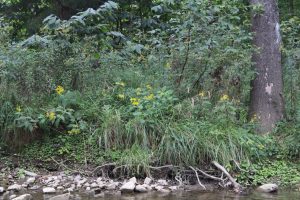
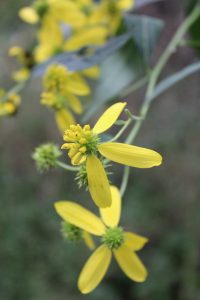 The flowers (lance-leaf coreopsis ) that are along the waters edge.
The flowers (lance-leaf coreopsis ) that are along the waters edge.
It was a lot of fun walking around my site. I loved seeing the differences already from the last time I had been there and am excited and curious to see what changes next when I go again soon! I did walk around only on my side so going across and experiencing the creek in the process was interesting. I really liked exploring the other side of the banks and will keep going across and all throughout the water until it becomes too cold to do so.
The main organisms that were the easiest for me to watch were the insects, minnows, and larger fish. The water beetles’ main adaptations were the ability to balance in the riffles through the mini waves in order to travel to other parts of the creek. They didn’t drown or spin out but angled their bodies and were able to close themselves up in order to torpedo through the riffle. The spider like water bugs maintained their ability to travel across the water’s surface without needing to fully extend their bodies to maintain balance. This created light, faster paced movements that helped keep them from making dimples on the water for fish to hear or see. Lastly, the dragonflies that came in and out of the woods to grab the water bugs were able to use their tails as a form of balance on the water surface by moving it back and forth while flattening their bodies quickly to stay afloat. The larger fish (small trout) showed that they can lay on the rocks just under eddies and wait for a few seconds for insects to fly over and attack them that way. They can maintain oxygen flow by slowly sliding their bodies across the algae-glossed rocks in order to blend in and not turn up and dirt. They made themselves blend into the shady spots of the rocks throughout the creek in order to attack the bugs as well. My favorite organisms to watch and observe their unique adaptations were the minnows. They were everywhere doing wild things! One that I saw were that they used the riffles to move from riffles to eddies. They did this by swimming quickly to the riffle then completely stiffening up and turn into a little twig. They then extended and twisted their pectoral fins to move them backwards to not lose control weaving around rocks and stronger water. Next was the use of the coloring to perfectly blend into the rocks by flipping their little bodies side to side in order to maintain any shimmer coming off of them from reflecting light. They bent in ways that did not allow light to reflect off them as strongly or at all. Lastly, the minnows had the ability to completely grapple onto a side of a rock, either in a riffle or eddy, and completely not move for long periods of time. They were able to somehow maintain oxygen flow with the slightest of movement while staying onto the rock that they used their pectoral and tail fin to latch onto. I saw this mainly in the eddies which was insane because the water was rushing so fast and was strong and they laid on the rocks completely still. Due to the water moving so quickly, they could be lost in seconds from the ripples and their coloring matching the rocks.

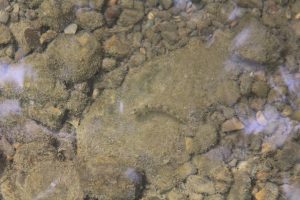 This is the minnow showing the adaptation of holding onto a rock and using the riffles and its color to blend in.
This is the minnow showing the adaptation of holding onto a rock and using the riffles and its color to blend in.
Wow! Your Sit-Spot sounds BEAUTIFUL!! I would love to go see it myself sometime during the fall! I loved how detailed you were in your observations, I could picture the water riffles and eddies in my mind, as well as the minnows swimming up the current! I hope that you see some activity from your dens soon, I would be curious to know whom might use them! I can’t wait for the next update 🙂
I absolutely love your sit spot! It reminds me of the small stream that just peeps through the forest line from the sit spot. Although mine is a much more densely populated neighborhood area. I think spending a nice afternoon in your area would make a perfect way to see fall come in. I’ve never seen a den like the one you have, although admittingly we don’t have a lot of dens in my area anyway. I really enjoyed looking at your three objects and your explanations, I hope you enjoyed your time outside too!